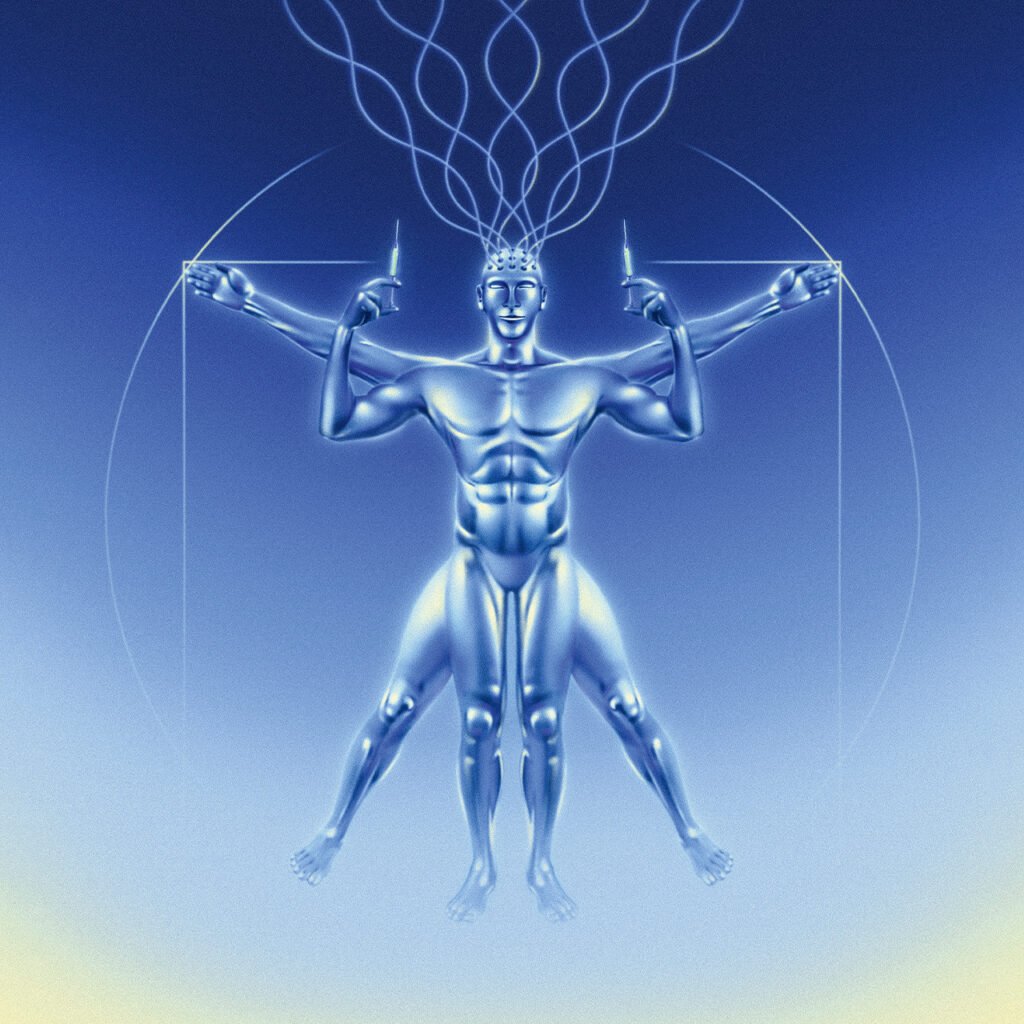
“Every boundary humankind has ever drawn was eventually revealed as a mirror, not a wall.”
There comes a moment in every civilization when the myths that once powered its ascent begin to expire. You can almost hear the quiet suffocation of meaning beneath the weight of our own ingenuity. We have mastered the genome, flirted with artificial consciousness, and yet remain trapped in a subtler prison – the one made of our assumptions about what it means to be human. The tragedy of modern progress is not that we have reached our limits, but that we have mistaken the limits of our imagination for the boundaries of reality.
The next frontier of evolution is not out there in the stars rather it is inward, within the vast uncharted corridors of human potential that still lie dormant beneath centuries of cognitive domestication. We have expanded our tools but not our selves. Our machines learn faster than our minds evolve. We have become artisans of efficiency, yet amateurs of meaning.
A child born today inherits more data than wisdom, more connectivity than communion. The modern psyche, for all its sophistication, suffers from a quiet malnutrition: a starvation of depth. We have built exoskeletons of progress without developing the inner musculature to bear the weight of our own inventions.
To speak of the limitless human is to defy the fatalism of biology, the tyranny of fixed intelligence, and the sociological reductionism that treats people as functions of systems rather than authors of reality. It is to reclaim agency as the raw material of evolution.
The Myth of the Finished Human
For centuries, we have spoken of human development as if it culminates in adulthood beyond which it now experiences a plateau where the mind settles and the soul calcifies. But evolution, in its truest sense, was never meant to stop at physiology. The physical form was only the scaffolding for a deeper transformation: the evolution of consciousness.
Our bodies are the relics of a long biological story; our minds, however, remain unfinished manuscripts. Yet most societies educate for conformity, not expansion. We teach children to adapt to outdated scripts, not to author new ones. The classroom trains obedience to past paradigms while the future waits outside, uninvited.
Consider the paradox: We live in the most information-rich era in history, yet our collective discernment grows poorer. Artificial intelligence advances exponentially, while human judgment decays logarithmically. We outsource cognition to algorithms and call it efficiency. But what happens when convenience becomes a substitute for consciousness? When predictive models begin to erode our capacity for original thought?
The danger is not that machines will surpass us rather the pattern shows it’s that we will voluntarily descend to meet them halfway.
The Evolution of Awareness
The next phase of human evolution will not be defined by genetic engineering or neuroprosthetics, though these will play supporting roles. It will be marked by a radical expansion in the architecture of awareness itself.
Imagine if consciousness were treated as a muscle, a field that strengthens through deliberate friction and purposeful engagement. Most people use only a fraction of their perceptual bandwidth, living in a narrow spectrum of thought and emotion. But what if the mind could be trained to operate across broader states such as fluid, adaptive, and meta-cognitive where one can simultaneously hold paradoxes without cognitive collapse?
This is what I call neuro-agility, the capacity to pivot across mental terrains with grace and coherence. It is the antidote to rigidity in an age of flux. In ancient traditions, mystics gestured toward it as enlightenment; in modern neuroscience, we glimpse its contours in neuroplasticity. Yet the principle remains timeless: the mind can be upgraded. Not through external enhancement, but through the disciplined cultivation of inner freedom.
The limitless human does not seek to conquer chaos but to harmonize with it. To find coherence not by resisting change but by metabolizing it.
Anecdotes of Expansion
History is generous with examples of those who glimpsed this higher horizon.
Nikola Tesla, the eccentric genius, once described his inventions as “visions” he saw fully formed in his mind before manifesting them into reality. What others dismissed as madness was, perhaps, an evolved mode of cognition of a mind that had learned to navigate beyond the conventional bandwidth of sensory perception.
Similarly, the polymath Leonardo da Vinci was not merely a painter or engineer but a prototype of fluid intelligence and through his curiosity operated like a river, not a tunnel. He intuited the unity of all disciplines centuries before systems thinking gave it a name.
Even the poet Rainer Maria Rilke, when asked how one becomes an artist, replied: “By ripening.” A word that defies mechanistic logic, it implies gestation, depth, time, and transformation. The limitless human ripens, not races.
The Science of Becoming
Recent studies in neurobiology suggest that the human brain remains capable of significant rewiring well into adulthood.
What we once assumed to be fixed in terms of our personality, intelligence, habits is now understood as malleable. Carol Dweck’s “growth mindset” and Jeffrey Schwartz’s work on neuroplasticity reveal a profound truth: identity itself is a skill, not a sentence.
Yet this insight remains philosophically underutilized. We have the science of plasticity but not the culture of it. The institutions that shape us in schools, workplaces, religions still operate as if people were static entities rather than evolving ecosystems. We measure performance but neglect potential.
The limitless human, therefore, represents both a biological and civilizational pivot, a recognition that the human project is still under construction.
The Crisis of Containment
Every era, to maintain order, builds cages for its geniuses. The Church once persecuted scientists for heresy; today, corporations smother creativity under the metrics of quarterly returns. The structures that once promised stability have become sanctuaries of smallness.
In a story I often recall, a young African inventor built a wind turbine from scrap materials to power his village. The global media celebrated him briefly, then moved on. But what the coverage missed was the deeper moral: human potential blooms not from privilege but from necessity. Innovation is evolution’s rebellion against despair.
When societies design systems that suppress experimentation, they stunt evolution itself. The limitless human is thus both social, political idea as much as a spiritual one signifying the needed rebellion against containment in all its forms.
The Regenerative Horizon
The future belongs to those who can regenerate as individuals and societies alike. Regeneration is not recovery; it is reinvention. It is the art of transforming adversity into new architecture.
In ecology, when a forest burns, it releases nutrients that enrich the soil for the next generation of growth. Likewise, civilizations must learn to metabolize their crises rather than collapse under them. The limitless human is the one who turns breakdown into blueprint.
We see glimpses of this in movements toward regenerative design, circular economies, and post-expert collaboration. Yet these external systems mirror an internal truth: no human can lead regeneration unless they have first undergone it within.
Becoming the Limitless Human
To become limitless is not to transcend the human condition but to deepen it and by this, to live with such intensity of awareness that even limitations become instruments of evolution. The limitless human is not immune to fear, loss, or failure; they simply learn to alchemize these into sources of insight.
As Baldwin once wrote, “The place in which I’ll fit will not exist until I make it.” That is the anthem of the next frontier fronting the audacity to sculpt one’s own coordinates of existence.
We are not awaiting the post-human age; we are birthing the fully human one. The future will not be written by those who adapt perfectly to the machine, but by those who remember how to feel, how to imagine, and how to create beyond instruction.
Epilogue: The Mirror and the Horizon
Stand before any mirror long enough, and you realize it is not reflecting you it is inviting you. Every evolution begins as an act of refusal: a refusal to remain confined by inherited definitions. The limitless human is the one who dares to step through that mirror to exchange the safety of the known for the vitality of the possible.
And perhaps, centuries from now, when our descendants look back on this epoch, they will not remember our technologies or our wars, but the quiet, defiant awakening of a species that finally remembered it could evolve on purpose.
About the author
Dr. Charles Obiajulu Ugwu is a Management consultant, adaptability thought leader, and regenerative systems expert. He writes and speaks on cognitive leadership, civilizational renewal, and human transformation.
![]()


